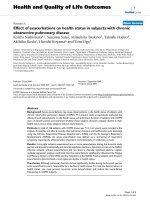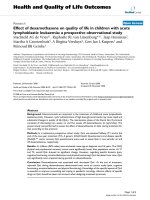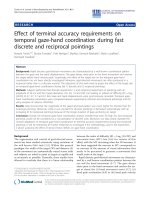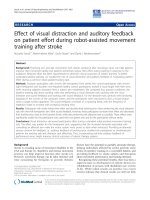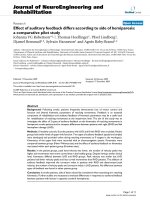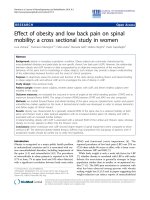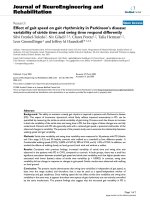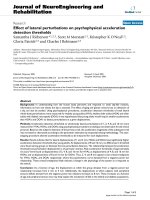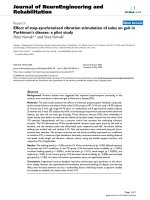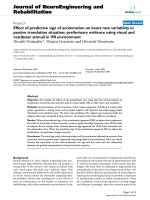báo cáo hóa học:" Effect of combined treatment with alendronate and calcitriol on femoral neck strength in osteopenic rats" doc
Bạn đang xem bản rút gọn của tài liệu. Xem và tải ngay bản đầy đủ của tài liệu tại đây (334.17 KB, 10 trang )
BioMed Central
Page 1 of 10
(page number not for citation purposes)
Journal of Orthopaedic Surgery and
Research
Open Access
Research article
Effect of combined treatment with alendronate and calcitriol on
femoral neck strength in osteopenic rats
Yoshinari Nakamura*
1
, Masatoshi Naito
1
, Kazuo Hayashi
2
, Abbas Fotovati
2
and Samah Abu-Ali
2
Address:
1
Department of Orthopaedic Surgery, Fukuoka University School of Medicine, Fukuoka, Japan and
2
Rheumatology and Arthritis Center
Fukuoka Wajiro Hospital 2-2-75, Wajirooka, Higashi-ku, Fukuoka, Japan
Email: Yoshinari Nakamura* - ; Masatoshi Naito - ;
Kazuo Hayashi - ; Abbas Fotovati - ; Samah Abu-Ali -
* Corresponding author
Abstract
Background: Hip fracture is associated with pronounced morbidity and excess mortality in
elderly women with postmenopausal osteoporosis. Many drugs have been developed to treat
osteoporosis and to reduce the risk of osteoporotic fractures. We investigated the effects of
combined alendronate and vitamin D
3
treatment on bone mass and fracture load at the femoral
neck in ovariectomized (OVX) rats, and evaluated the relationship between bone mass parameters
and femoral neck strength.
Methods: Thirty 12-week-old female rats underwent either a sham-operation (n = 6) or OVX (n
= 24). Twenty weeks later, OVX rats were further divided into four groups and received daily
doses of either saline alone, 0.1 mg/kg alendronate, 0.1 μg/kg calcitriol, or a combination of both
two drugs by continuous infusion via Alzet mini-osmotic pumps. The sham-control group received
saline alone. After 12 weeks of treatment, femoral necks were examined using peripheral
quantitative computed tomography (pQCT) densitometry and mechanical testing.
Results: Saline-treated OVX rats showed significant decreases in total bone mineral content
(BMC) (by 28.1%), total bone mineral density (BMD) (by 9.5%), cortical BMC (by 26.3%), cancellous
BMC (by 66.3%), cancellous BMD (by 29.0%) and total cross-sectional bone area (by 30.4%)
compared with the sham-control group. The combined alendronate and calcitriol treatments
improved bone loss owing to estrogen deficiency. On mechanical testing, although OVX
significantly reduced bone strength of the femoral neck (by 29.3%) compared with the sham-
control group, only the combined treatment significantly improved the fracture load at the femoral
neck in OVX rats to the level of the sham-controls. The correlation of total BMC to fracture load
was significant, but that of total BMD was not.
Conclusion: Our results showed that the combined treatment with alendronate and calcitriol
significantly improved bone fragility of the femoral neck in OVX osteopenic rats.
Published: 17 December 2008
Journal of Orthopaedic Surgery and Research 2008, 3:51 doi:10.1186/1749-799X-3-51
Received: 10 February 2008
Accepted: 17 December 2008
This article is available from: />© 2008 Nakamura et al; licensee BioMed Central Ltd.
This is an Open Access article distributed under the terms of the Creative Commons Attribution License ( />),
which permits unrestricted use, distribution, and reproduction in any medium, provided the original work is properly cited.
Journal of Orthopaedic Surgery and Research 2008, 3:51 />Page 2 of 10
(page number not for citation purposes)
Background
Osteoporosis occurring as a result of estrogen deficiency
after the menopause is associated with a rapid increase in
the risk of serious fractures [1]. Among such osteoporotic
fractures, those of the hip present a major health problem
with prolonged hospitalization, decreased quality of life,
and increased risk of death [2]. It is estimated that the
worldwide incidence of hip fractures will rise from 1.66
million in 1990 to 6.26 million by 2050 [3]. Therefore, to
prevent hip fractures associated with minimal trauma in
people with osteoporosis, effective treatments, which con-
fer enhanced bone strength, particularly at the femoral
neck, are needed.
Bisphosphonates inhibit bone resorption as they are
selectively incorporated into osteoclasts and interfere with
the resorptive action of osteoclasts [4]. Alendronate is a
second generation bisphosphonate, and is widely used for
postmenopausal, male, and glucocorticoid-induced oste-
oporosis. The effect of a single treatment of alendronate
for postmenopausal osteoporosis to prevent femoral neck
fracture has been shown in clinical [5,6], and animal stud-
ies [7,8].
Vitamin D
3
is also given as a treatment for osteoporosis;
evidence that vitamin D
3
[1,25(OH)
2
D
3
] increases bone
mineral density (BMD) and reduces hip fractures in post-
menopausal osteoporosis has been reported [9], but other
studies have shown no effect of the drug on bone mass
[10,11]. Therefore, the effect of vitamin D
3
for treatment
of osteoporosis women remains controversial. However,
in animal studies, vitamin D
3
has been reported to prevent
cortical and cancellous bone loss owing to estrogen defi-
ciency by inhibiting bone resorption [12,13]. Vitamin D
3
at higher doses shows a bone anabolic action by enhanc-
ing osteoblast activity [14].
A combination of two different drugs is believed to be a
more effective treatment than a single treatment for oste-
oporosis; the combination of bisphosphonate and a bone
anabolic drug has been used clinically [15,16]. Combined
alendronate and calcitriol treatments have been reported
to be more beneficial for BMD of the femoral neck than
either alendronate or calcitriol alone in postmenopausal
osteoporosis [15]. BMD is the most clinically relevant
determinant of bone strength in human osteoporosis.
However, there are no satisfactory clinical means to inves-
Total BMC at the proximal, middle and distal parts of the femoral neck measured by pQCT densitometryFigure 1
Total BMC at the proximal, middle and distal parts of the femoral neck measured by pQCT densitometry.
Effects of alendronate (ALN), calcitriol (VitD), and combined alendronate and calcitriol treatments (ALN+VitD) on the pQCT
densitometric parameters of total BMC at the 3 parts of the femoral neck in OVX rats after 12 weeks of treatment are shown.
The data are presented as mean ± SD (n = 6 per group).
###
P < 0.001 as compared with corresponding values in saline-treated
OVX (unpaired t-test). * P < 0.05, ** P < 0.01, *** P < 0.001 as compared with corresponding values in saline-treated OVX
(Tukey's multiple comparison test). Total BMC at the 3 parts of the femoral neck was significantly lower in the saline-treated
OVX compared with the sham group. Alendronate treatment, with or without calcitriol, induced a significant improvement in
all total BMC.
4
5
6
7
Total BMC (mg/mm)
**
###
**
*
*
###
**
**
*
***
###
0
1
2
3
Sham OVX OVX
+ALN
OVX
+Vit.D
OVX
+ALN
+Vit.D
Sham OVX OVX
+ALN
OVX
+Vit.D
OVX
+ALN
+Vit.D
Sham OVX OVX
+ALN
OVX
+Vit.D
OVX
+ALN
+Vit.D
Journal of Orthopaedic Surgery and Research 2008, 3:51 />Page 3 of 10
(page number not for citation purposes)
tigate the relationship between BMD and bone strength;
therefore, the relationship has been investigated in ova-
riectomized rats as a model of postmenopausal oste-
oporosis [7,8,17-20]. To the best of our knowledge, no
study has assessed whether the combination of alendro-
nate and vitamin D
3
enhances the mechanical strength of
femoral necks, which clinically is a more interesting site at
which to assess measurements.
Owing to the different mechanisms of action of these
agents, our hypothesis was that the combination of alen-
dronate and vitamin D
3
would facilitate greater improve-
ments in bone mass and strength at the femoral neck than
either intervention alone. Therefore, we aimed to investi-
gate the effect of combined treatment with alendronate
and calcitriol on bone mass by assessing peripheral quan-
titative computed tomography (pQCT) and on fracture
load at the femoral neck in ovariectomized rats, and com-
paring the bone mass parameters with the fracture load at
the femoral neck.
Methods
Experimental design
This study protocol was approved by the Fukuoka Univer-
sity Animal Care and Use Committee. Thirty 11-week-old
female Wistar rats, mean weight 277.9 (SD 13.4) g, were
purchased from Seac Co. Ltd (Fukuoka, Japan) and accli-
mated to conditions for 1 week before the experiments.
All rats were maintained in separate plastic cages under
normal conditions (22–26°C; air humidity 55–60%; 12 h
light/dark cycle). They had free access to food and water.
At 12 weeks of age the rats were randomly divided into
two groups, bilaterally ovariectomized (OVX: n = 24) and
sham-operated (Sham-control: n = 6) under anaesthesia
induced by intraperitoneal injection with sodium pento-
barbital (40 mg/kg/ml, Dinabot Inc, Osaka, Japan).
Twenty weeks after surgery, the OVX rats were further
divided into four groups (n = 6 per group). The four OVX
groups were treated for 12 weeks with daily doses of either
saline alone, 0.1 mg/kg of alendronate (monosodium 4-
amino-1-hydroxybutylidene-1, 1-diphosphonate trihy-
drate), 0.1 μg/kg of calcitriol [1,25(OH)
2
D
3
], or a treat-
ment combining alendronate and calcitriol. Doses were
Total BMD at the proximal, middle and distal parts of the femoral neck measured by pQCT densitometryFigure 2
Total BMD at the proximal, middle and distal parts of the femoral neck measured by pQCT densitometry.
Effects of alendronate (ALN), calcitriol (VitD), and combined alendronate and calcitriol treatments (ALN+VitD) on the pQCT
densitometric parameters of total BMD at the 3 parts of the femoral neck in OVX rats after 12 weeks of treatment are shown.
The data are presented as mean ± SD (n = 6 per group).
#
P < 0.05,
##
P < 0.01 as compared with corresponding values in
saline-treated OVX (unpaired t-test). * P < 0.05, ** P < 0.01, *** P < 0.001 as compared with corresponding values in saline-
treated OVX (Tukey's multiple comparison test). In the middle and distal parts of the femoral neck, total BMD was significantly
lower in the saline-treated OVX compared with the sham group. In total BMD of these parts, alendronate treatment, with or
without calcitriol, showed a significant improvement.
1000
1500
Total BMD (mg/cm
3
)
#
**
*
##
*
***
0
500
Sham OVX OVX
+ALN
OVX
+Vit.D
OVX
+ALN
+Vit.D
Sham OVX OVX
+ALN
OVX
+Vit.D
OVX
+ALN
+Vit.D
Sham OVX OVX
+ALN
OVX
+Vit.D
OVX
+ALN
+Vit.D
Journal of Orthopaedic Surgery and Research 2008, 3:51 />Page 4 of 10
(page number not for citation purposes)
delivered by mini-osmotic pumps (Alzet Pump, Alza Cor-
poration, Palo Alto, CA) implanted subcutaneously and
replaced every 4 weeks. Alendronate was dissolved in
phosphate-buffered saline, and calcitriol was dissolved in
propylene glycol immediately before implantation. The
0.1 mg/kg alendronate and 0.1 μg/kg calcitriol doses were
chosen according to the results of earlier studies [21-23].
The sham-control group received saline alone by mini-
osmotic pumps for 12 weeks. After 12 weeks of treatment,
all animals were sacrificed with an overdose of pentobar-
bital and their bilateral femora excised.
pQCT densitometry
The cross-sections of the left femoral necks were scanned
using a pQCT system (XCT Research SA+, Software ver-
sion 5.50e, Stratec Medizintechnik GmbH, Pforzhein,
Germany). This system has a 50 kV/0.3 mA X-ray source.
On a scout view of the femoral neck, three scan lines were
manually placed so that the cross-sectional slice passed at
every 0.2 mm through the mid-point and the proximal
and distal ends of the longitudinal axis of the femoral
neck. The scan time was 7.0 min and voxel size 0.08 × 0.08
× 0.46 mm. At the three points of the femoral neck, total
bone mineral content (total BMC), total bone mineral
density (total BMD), cortical BMC, cortical BMD, cancel-
lous BMC, cancellous BMD, cortical bone thickness and
total cross-sectional bone area (total bone area) were
recorded using the pQCT software. The means of these
values at the three points were then calculated. The coeffi-
cient of variation for the pQCT measurements was less
than 5%.
Mechanical testing
The mechanical strength of the femoral neck was meas-
ured by applying a vertical load to the femoral head using
a Shimadzu EZ-1 pressure system (Shimadzu, Osaka,
Japan). After the femora had been slowly thawed at room
temperature, soft tissues were removed from the femora
and the shafts of the femora cut at the mid-shaft of each
femur. The distal femora were fixed with methylmethacr-
ylate cement up to the lesser trochanter, maintaining a
vertical position [17,18]. A vertical load from a brass cyl-
inder was applied to the top of the femoral head. The cyl-
inder was directed parallel to the axis of the femoral
diaphysis and moved at a constant displacement speed of
5 mm/min until the femoral neck fractured. The fracture
Total BMC and BMD at the femoral neck measured by pQCT densitometryFigure 3
Total BMC and BMD at the femoral neck measured by pQCT densitometry. Effects of alendronate (ALN), calcitriol
(VitD), and combined alendronate and calcitriol treatments (ALN+VitD) on the pQCT densitometric parameters of total BMC
and BMD at the femoral neck in OVX rats after 12 weeks of treatment are shown. The data are presented as mean ± SD (n =
6 per group).
#
P < 0.05,
###
P < 0.001 as compared with corresponding values in saline-treated OVX (unpaired t-test). * P <
0.05, ** P < 0.01 as compared with corresponding values in saline-treated OVX (Tukey's multiple comparison test). Total BMC
and BMD were significantly lower in the saline-treated OVX compared with the sham group. Alendronate treatment, with or
without calcitriol, induced a significant improvement in both total BMC and BMD.
1000
1500
Total BMD (mg/cm
3
)
#
**
*
4
5
6
7
Total BMC (mg/mm)
###
**
*
**
**
*
**
0
500
Sham OVX OVX
+ALN
OVX
+Vit.D
OVX
+ALN
+Vit.D
0
1
2
3
4
Sham OVX OVX
+ALN
OVX
+Vit.D
OVX
+ALN
+Vit.D
Journal of Orthopaedic Surgery and Research 2008, 3:51 />Page 5 of 10
(page number not for citation purposes)
load was recorded at the peak force as Newton (N) at the
point that the femoral neck fractured.
Statistical analysis
The results for each group are expressed as means ± stand-
ard deviation (SD). The comparison between the sham-
operation group (n = 6) and the OVX control group (n =
6) was done by unpaired t-tests. Differences between
treated groups (n = 6 per group) were calculated by two-
way factorial analysis of variance (ANOVA) test followed
by Tukey's multiple comparison test as a post hoc test.
Linear regression analysis was used to correlate bone mass
parameters with bone strength. P values of < 0.05 were
considered significant.
Results
pQCT densitometry
Total BMC at the proximal, middle and distal parts of the
femoral neck in saline-treated OVX group was signifi-
cantly lower than those in the sham-control group (p <
0.001, p < 0.001, and p < 0.001, respectively) (Fig. 1).
Alendronate and calcitriol alone, and in combination sig-
nificantly improved total BMC in the proximal (p = 0.003,
p = 0.041, and p < 0.001, respectively) and middle parts
(p = 0.007, p = 0.044, and p = 0.003, respectively) of the
femoral neck. The total BMC at the distal parts with alen-
dronate alone or in combination with calcitriol was signif-
icantly higher than that in the saline-treated OVX group (p
= 0.028 and p = 0.004, respectively). In the middle and
distal parts, the total BMD of the saline-treated OVX group
was lower than that of the sham-control group (p = 0.013
and p = 0.006, respectively) (Fig. 2). The total BMD at the
middle and distal parts was significantly higher with alen-
dronate alone than in the saline-treated OVX group (p =
0.007 and p < 0001, respectively). Total BMD at the distal
parts with combined treatment was greater than that in
the saline-treated OVX group (p = 0.031). The means of
total BMC, total BMD, cortical BMC, cortical BMD, cancel-
lous BMD, cancellous BMC, cortical bone thickness and
total bone area at the three parts are shown in Figures 3,
4, 5, 6.
In the saline-treated OVX group, a statistically significant
reduction of total BMC by 28.1% (p < 0.001), total BMD
by 9.5% (p = 0.016), cortical BMC by 26.3% (p < 0.001),
cancellous BMC by 66.3% (p < 0.001), cancellous BMD
Cortical BMC and BMD at the femoral neck measured by pQCT densitometryFigure 4
Cortical BMC and BMD at the femoral neck measured by pQCT densitometry. Effects of alendronate (ALN), calci-
triol (VitD), and combined alendronate and calcitriol treatments (ALN+VitD) on the pQCT densitometric parameters of cor-
tical BMC and BMD at the femoral neck in OVX rats after 12 weeks of treatment are shown. The data are presented as mean
± SD (n = 6 per group).
###
P < 0.001 as compared with corresponding values in saline-treated OVX (unpaired t-test). * P <
0.05, ** P < 0.01, *** P < 0.001 as compared with corresponding values in saline-treated OVX (Tukey's multiple comparison
test). Cortical BMC was significantly lower in the saline-treated OVX than in the sham group. Cortical BMC in OVX rats was
significantly improved by alendronate, calcitriol single treatment, and the combined treatment.
1000
1500
Cortical BMD (mg/cm
3
)
5
6
7
Cortical BMC (mg/mm)
###
**
**
***
0
500
1000
Sham OVX OVX
+ALN
OVX
+Vit.D
OVX
+ALN
+Vit.D
0
1
2
3
4
Sham OVX OVX
+ALN
OVX
+Vit.D
OVX
+ALN
+Vit.D
Journal of Orthopaedic Surgery and Research 2008, 3:51 />Page 6 of 10
(page number not for citation purposes)
by 29.0% (p < 0.001), and total bone area by 30.4% (p <
0.001) were shown when compared with the sham-con-
trol group (Figs. 3, 4, 5, 6). Alendronate and calcitriol
alone, and in combination significantly improved total
BMC (p = 0.009, p = 0.046, and p = 0.006; respectively;
Fig. 3), cortical BMC (p = 0.005, p = 0.009, and p < 0.001,
respectively; Fig. 4), and cancellous BMC (p = 0.033, p =
0.045, and p = 0.033, respectively; Fig. 5) in OVX rats
compared with the saline-treated OVX group. Addition-
ally, with both alendronate alone and in combination
with calcitriol, total BMD (p = 0.005 and p = 0.047,
respectively; Fig. 3) and cancellous BMD (p < 0.001 and p
< 0.001, respectively; Fig.5) were significantly greater than
in the saline-treated OVX group. Calcitriol alone and in
combination with alendronate achieved significantly
higher total bone area values in OVX rats compared with
the saline-treated OVX group (p < 0.001 and p < 0.001,
respectively; Fig. 6).
Mechanical testing
The average maximum fracture loading to the femoral
necks was 29.3% lower in the saline-treated OVX group
compared with the sham-control group (p = 0.046) (Fig.
7). Femoral neck strength in all treated OVX groups was
higher than that in the saline-treated OVX group, but only
the combined treatment showed a significant difference
compared with the saline-treated OVX group (p = 0.007).
All femoral neck fractures were observed to be midcervi-
cal.
Relationship between bone mass parameters and fracture
load at the femoral neck
In all groups, total BMC, cortical BMC and total bone area
were found to be correlated with fracture load at the fem-
oral neck, with total BMC showing the highest; in con-
trast, total BMD and fracture load were not significantly
correlated (Additional file 1, Fig. 8). Additionally, in the
alendronate and calcitriol alone or in combination
groups, total BMC and fracture load were significantly cor-
related (Additional file 1).
Discussion
Our study revealed that combination therapy with alendr-
onate and calcitriol significantly improved bone mass and
femoral neck strength in OVX rats. The results indicated
Cancellous BMC and BMD at the femoral neck measured by pQCT densitometryFigure 5
Cancellous BMC and BMD at the femoral neck measured by pQCT densitometry. Effects of alendronate (ALN),
calcitriol (VitD), and combined alendronate and calcitriol treatments (ALN+VitD) on the pQCT densitometric parameters of
cancellous BMC and BMD at the femoral neck in OVX rats after 12 weeks of treatment are shown. The data are presented as
mean ± SD (n = 6 per group).
###
P < 0.001 as compared with corresponding values in saline-treated OVX (unpaired t-test). *
P < 0.05, *** P < 0.001 as compared with corresponding values in saline-treated OVX (Tukey's multiple comparison test).
OVX significantly reduced cancellous BMC and BMD. In alendronate single and the combined treatment group, a significant
increment in both cancellous BMC and BMD was found. Calcitriol single treatment significantly improved cancellous BMC only.
1000
1500
Cancellous BMD (mg/cm
3
)
###
***
***
1.5
2
Cancellous BMC (mg/mm)
###
*
*
*
0
500
1000
Sham OVX OVX
+ALN
OVX
+Vit.D
OVX
+ALN
+Vit.D
0
0.5
1
Sham OVX OVX
+ALN
OVX
+Vit.D
OVX
+ALN
+Vit.D
*
Journal of Orthopaedic Surgery and Research 2008, 3:51 />Page 7 of 10
(page number not for citation purposes)
that total BMC values had the strongest correlation with
the mechanical strength of the femoral neck.
Several studies [7,8] have demonstrated the effect of a sin-
gle treatment of alendronate on the mechanical strength
of the femoral neck in OVX rats. In the first study, starting
alendronate immediately after OVX at dose of 0.04 mg/
kg/day and 1.0 mg/kg/day significantly increased the
strength of the femoral neck in OVX rats after 8 weeks of
treatment [7]. However, the effects of alendronate on fem-
oral neck strength in these OVX rats were not dose
dependent. The second study [8] showed that the femoral
neck strength of rats receiving alendronate at a dose of 3
mg/kg/day was significantly greater than that of OVX con-
trol rats, even though alendronate was administered to
OVX rats for 4 weeks and started on the second day after
OVX. In the present study, the dose of 0.1 mg/kg/day of
alendronate increased the maximum fracture loading at
the femoral neck in OVX rats, but this was not significant
compared with the saline-treated OVX rats. The difference
between the two above reports and our results may be due
to differences in the period of time from ovariectomy to
initiating treatment. It is possible that this period of time
may also be partly responsible for differences in results
with vitamin D
3
treatment between postmenopausal
women with osteoporosis [10,11] and ovariectomized
rats [12,13]. Since osteoporosis associated with estrogen
deficiency is a silent disease, when patients start treatment
with various drugs, osteoporosis is already well estab-
lished; therefore, in the present study all treatments were
started at 20 weeks after ovariectomy.
Our OVX rats had significantly decreased total BMC, total
BMD, cortical BMC, cancellous BMC, cancellous BMD,
and total bone area at the femoral neck compared with
sham-controls. The combination therapy with alendro-
nate and calcitriol reverted these levels towards those
observed in the sham-operated rats. However, these find-
ings, excluding that for total bone area, were also observed
with alendronate alone. Therefore, no synergistic effects of
alendronate and calcitriol were observed in terms of bone
mass in OVX rats.
In terms of the mechanical strength of the femoral neck,
the present study showed no difference between alendro-
nate alone or in combination with calcitriol, but only
Cortical thickness and total bone area at the femoral neck measured by pQCT densitometryFigure 6
Cortical thickness and total bone area at the femoral neck measured by pQCT densitometry. Effects of alendro-
nate (ALN), calcitriol (VitD), and combined alendronate and calcitriol treatments (ALN+VitD) on the pQCT densitometric
parameters of cortical thickness and total bone area at the femoral neck in OVX rats after 12 weeks of treatment are shown.
The data are presented as mean ± SD (n = 6 per group).
###
P < 0.001 as compared with corresponding values in saline-treated
OVX (unpaired t-test). *** P < 0.001 as compared with corresponding values in saline-treated OVX (Tukey's multiple compar-
ison test). Total bone area was significantly decreased by OVX. Calcitriol single and the combined treatment induced a signifi-
cant improvement in total bone area.
5
6
7
Total Bone Area (mm
2
)
###
*** ***
0.8
1
Cortical Thickness (mm)
0
1
2
3
4
Sham OVX OVX
+ALN
OVX
+Vit.D
OVX
+ALN
+Vit.D
0
0.2
0.4
0.6
Sham OVX OVX
+ALN
OVX
+Vit.D
OVX
+ALN
+Vit.D
Journal of Orthopaedic Surgery and Research 2008, 3:51 />Page 8 of 10
(page number not for citation purposes)
combination treatment of alendronate and calcitriol for
12 weeks significantly improved bone fragility owing to
ovariectomy compared with the saline-treated OVX rats.
For this reason, we also believe it is of interest that OVX
rats treated with the combined treatment showed
enhanced total BMC, cortical BMC, and total bone area,
which are all correlated with femoral neck strength.
Among the three parameters in bone mass, total BMC and
cortical BMC were increased by alendronate, and total
bone area was improved by calcitriol. Therefore, a com-
bined treatment that reflects differences in functions of
the two agents on bone mass, might significantly improve
femoral neck strength.
Even though clinical studies have reported correlations
between BMD and the incidence of femoral neck fracture
in osteoporosis patients [5], our results found no correla-
tion between BMD and femoral neck strength in rats. In
fact, in our study, femoral neck strength was only corre-
lated total BMC, cortical BMC, and total bone area. Our
findings are in agreement with several other reports
[24,25]. In healthy rats, femoral neck strength was shown
to be correlated only with BMC and not BMD [24]. Mean-
while, in gastrectomized osteopenic rats, BMD was not
correlated with femoral neck strength [25]. Furthermore,
in another study, in which OVX rats were treat with
human insulin-like growth factor-I (IGF-I) alone or in
combination with pamidronate, although BMD and BMC
were correlated with femoral neck strength, the associa-
tion was stronger for BMC than for BMD [17]. In addition,
cortical bone properties are of great interest in osteoporo-
sis, since it is widely speculated that cortical bone quality
does affect fracture risk. In this study, we measured corti-
cal BMC, BMD and cortical thickness as markers of corti-
cal bone quality. Of these, cortical BMC was positively
correlated with the femoral neck strength in OVX rats.
However, since the femoral neck strength is also affected
by other parameters such as external diameter of the fem-
oral neck, hip axis length [26], cortical porosis, mean
degree of mineralization, and osteocytes, it may be diffi-
cult to evaluate the determinants of neck strength.
We note several limitations of our study. First, although
12-week-old female rats with growing bones were used in
the present study, a baseline control group was not
included for comparison. However, as the treatments
were started 20 weeks after ovariectomy and lasted 12
weeks, the rats were 8 months old (32 weeks) when treat-
ment started, and 11 months old when bone mass and
strength were investigated. Second, the modest number of
rats means that the power of the study to demonstrate sta-
tistically significant differences was relatively low. With
more rats, any synergistic effect of combination alendro-
nate and calcitriol therapy on bone mass and strength
might become evident. Finally, we did not examine bone
strength of the femoral neck in a configuration simulating
a fall to the lateral side. The fall configuration is clinically
more relevant because most osteoporotic hip fractures are
associated with a fall [27]. In the fall loading configura-
tion, it is important to consider anteversion of the femoral
neck. However, this has yet to be clarified in rats. There-
fore, we investigated the fracture load at the femoral neck
in a direction parallel to the femoral shaft axis; however,
the axial loading may influence the fracture types owing to
different internal stress distributions. Although approxi-
mately half of osteoporotic hip fractures are intertro-
chanteric in human [28], all fractures in the present study
were found in midcervical region.
Clinical studies have shown that vitamin D
3
is effective in
increasing BMD and reducing hip fractures in postmenop-
osal osteoporosis [9]; however, others have failed to repro-
duce the same results [10]. On the other hand, in animal
Mechanical strength of the femoral neckFigure 7
Mechanical strength of the femoral neck. Mechanical
results of femoral neck fractures in sham control rats, and
OVX rats that received saline, alendronate (ALN), calcitriol
(VitD), or combined alendronate and calcitriol treatments
(ALN+VitD) for 12 weeks. The data are presented as mean ±
SD (n = 6 per group).
#
P < 0.05 as compared with corre-
sponding values in saline-treated OVX (unpaired t-test).* P <
0.05 as compared with corresponding values in saline-treated
OVX (Tukey's multiple comparison test). Bone strength of
the femoral neck was significantly lower in the saline-treated
OVX compared with the sham group. The bone strength in
OVX rats was significantly improved by the combined alendr-
onate and calcitriol treatment but not by alendronate or cal-
citriol single treatment.
120
160
Fracture Load (N)
#
**
0
40
80
Sham OVX OVX
+ALN
OVX
+Vit.D
OVX
+ALN
+Vit.D
Journal of Orthopaedic Surgery and Research 2008, 3:51 />Page 9 of 10
(page number not for citation purposes)
studies using OVX rats, vitamin D
3
treatment prevented
bone loss occurring as a result of estrogen deficiency
[12,13]. Since the bone remodeling period in OVX rats is
shorter than that in humans [29], the reason for the dis-
crepancy between OVX rats and humans is may be related
to enhanced remodeling activity in the rat. In addition, the
discrepancy may be due to a genetic difference in the sensi-
tivity to vitamin D between rats and humans [30].
In summary, the present study showed that combination
therapy with alendronate and calcitriol significantly
restored cortical and cancellous bone loss that was due to
estrogen deficiency in OVX rats. Although no synergistic
effects of the two agents were found in terms of bone mass
at the femoral neck, the combined treatment does reflect
the effects of the two agents. On mechanical testing, our
results demonstrated that the combined treatment signif-
icantly improved bone fragility of the femoral neck in
osteopenic conditions.
Competing interests
The authors declare that they have no competing interests.
Authors' contributions
YN and MN designed the research. YN, AF and SA did the
experiment and analyzed the data. YN wrote the draft man-
uscript and MN, KH and AF revised the draft manuscript.
Additional material
References
1. Watts NB: Postmenopausal osteoporosis. Obstet Gynecol Surv
1999, 54:532-8.
2. Chrischilles EA, Butler CD, Davis CS, Wallace RB: A model of life-
time osteoporosis impact. Arch Intern Med 1991, 151:2026-32.
3. Cooper C, Campion G, Melton LJ: Hip fractures in the elderly: a
world-wide projection. Osteoporos Int 1992, 2:285-89.
4. Rodan GA: Mechanisms of action of bisphosphonates. Annu Rev
Pharmacol Toxicol 1998, 38:375-88.
5. Black DM, Cummings SR, Karpf DB, Cauley JA, Thompson DE, Nevitt
MC, Bauer DC, Genant HK, Haskell WL, Marcus R, Ott SM, Torner
JC, Quandt SA, Reiss TF, Ensrud KE: Randomised trial of effect of
alendronate on risk of fracture in women with existing ver-
tebral fractures. Lancet 1996, 348:1535-41.
6. Hochberg MC, Thompson DE, Black DM, Quandt SA, Cauley J, Geu-
sens P, Ross PD, Baran D: Effect of alendronate on the age-spe-
Additional file 1
Relation between bone mass parameters and fracture load at the fem-
oral neck. In all groups, there were significant correlations between the
fracture load and total BMC, cortical BMC or total bone area at the fem-
oral neck. In all groups, the alendronate-treated groups (ALN and ALN +
Vit.D), the calcitriol-treated groups (Vit.D and ALN + Vit.D) and com-
bined treatment group, there were significant correlation between the frac-
ture load and total BMC in the femoral neck.
Click here for file
[ />799X-3-51-S1.pdf]
Relationship between bone mass and fracture load at the femoral neckFigure 8
Relationship between bone mass and fracture load at the femoral neck. A relationship was found between total
BMC and fracture load at the femoral neck, but no relationship between total BMD and fracture load at the femoral neck was
observed. The values of the correlation coefficient (r) and correlation significance (p) are described in Additional file 1.
Load = 19.34+0.076×Total BMD
R² = 0.095
120
140
160
180
200
Load = 27.05+16.7×Total BMC
R² = 0.294
120
140
160
180
200
o
ad (N)
20
40
60
80
100
120
900 1000 1100 1200 1300 1400
Total BMD (mg/cm
3
)
20
40
60
80
100
120
34567
Fracture L
o
Total BMC (mg/mm)
Publish with BioMed Central and every
scientist can read your work free of charge
"BioMed Central will be the most significant development for
disseminating the results of biomedical research in our lifetime."
Sir Paul Nurse, Cancer Research UK
Your research papers will be:
available free of charge to the entire biomedical community
peer reviewed and published immediately upon acceptance
cited in PubMed and archived on PubMed Central
yours — you keep the copyright
Submit your manuscript here:
/>BioMedcentral
Journal of Orthopaedic Surgery and Research 2008, 3:51 />Page 10 of 10
(page number not for citation purposes)
cific incidence of symptomatic osteoporotic fractures. J Bone
Miner Res 2005, 20:971-6.
7. Azuma Y, Oue Y, Kanatani H, Ohta T, Kiyoki M, Komoriya K: Effects
of continuous alendronate treatment on bone mass and
mechanical properties in ovariectomized rats: comparison
with pamidronate and etidronate in growing rats. J Pharmacol
Exp Ther 1998, 286:128-35.
8. Rliwinski L, Janiec W, Pytlik M, Folwarczna J, Kaczmarczyk-Sedlak I,
Pytlik W, Cegiela U, Nowinska B: Effect of administration of
alendronate sodium and retinol on the mechanical proper-
ties of the femur in ovariectomized rats. Pol J Pharmacol 2004,
56:817-24.
9. Chapuy MC, Arlot ME, Duboeuf F, Brun J, Crouzet B, Arnaud S, Del-
mas PD, Meunier PJ: Vitamin D
3
and calcium to prevent hip
fractures in the elderly women. N Engl J Med 1992, 327:1637-42.
10. Falch JA, Odegaard OR, Finnanger AM, Matheson I: Postmenopau-
sal osteoporosis: no effect of three years treatment with
1,25-dihydroxycholecalciferol. Acta Med Scand 1987,
221:199-204.
11. Ott SM, Chesnut CH: Calcitriol treatment is not effective in
postmenopausal osteoporosis. Ann Intern Med 1989, 110:267-74.
12. Erben RG, Weiser H, Sinowatz F, Rambeck WA, Zucker H: Vitamin
D metabolites prevent vertebral osteopenia in ovariect-
omized rats. Calcif Tissue Int 1992, 50:228-36.
13. Shiraishi A, Takeda S, Masaki T, Higuchi Y, Uchiyama Y, Kubodera N,
Sato K, Ikeda K, Nakamura T, Matsumoto T, Ogata E: Alfacalcidol
inhibits bone resorption and stimulates formation in an ova-
riectomized rat model of osteoporosis: distinct actions from
estrogen. J Bone Miner Res 2000, 15:770-9.
14. Erben RG, Scutt AM, Miao D, Kollenkirchen U, Haberey M: Short-
term treatment of rats with high dose 1,25-dihydroxyvita-
min D
3
stimulates bone formation and increases the number
of osteoblast precursor cells in bone marrow. Endocrinology
1997, 138:4629-35.
15. Frediani B, Allegri A, Bisogno S, Marcolongo R: Effects of combined
treatment with calcitriol plus alendronate on bone mass and
bone turnover in postmenopausal osteoporosis: two years of
continuous treatment. Clin Drug Invest 1998, 15:235-44.
16. Malavolta N, Zanardi M, Veronesi M, Ripamonti C, Gnudi S: Calci-
triol and alendronate combination treatment in menopausal
women with low bone mass. Int J Tissue React 1999, 21:51-9.
17. Ammann P, Rizzoli R, Meyer JM, Bonjour JP: Bone density and
shape as determinants of bone strength in IGF-I and/or
pamidronate-treated ovariectomized rats. Osteoporos Int
1996, 6:219-27.
18. Bagi CM, Ammann P, Rizzoli R, Miller SC: Effect of estrogen defi-
ciency on cancellous and cortical bone structure and
strength of the femoral neck in rats. Calcif Tissue Int 1997,
61:336-44.
19. Peng Z, Tuukkanen J, Zhang H, Vaananen HK: Alteration in the
mechanical competence and structural properties in the
femoral neck and vertebrae of ovariectomized rats. J Bone
Miner Res 1999, 14:616-23.
20. Ito M, Azuma Y, Takagi H, Komoriya K, Ohta T, Kawaguchi H: Cur-
ative effect of combined treatment with alendronate and 1
alpha-hydroxyvitamin D
3
on bone loss by ovariectomy in
aged rats. Jpn J Pharmacol 2002, 89:255-66.
21. Kabasawa Y, Asahina I, Gunji A, Omura K: Administration of par-
athyroid hormone, prostaglandin E
2
, or 1-alpha, 25-dihy-
droxyvitamin D
3
restores the bone inductive activity of
rhBMP-2 in aged rats. DNA Cell Biol 2003, 22:541-546.
22. Stabnov L, Kasukawa Y, Guo R, Amaar Y, Wergedal JE, Baylink DJ,
Mohan S: Effect of insulin-like growth factor-1 (IGF-1) plus
alendronate on bone density during puberty in IGF-1-defi-
cient MIDI mice. Bone 2002, 30:909-16.
23. Thompson DD, Seedor JG, Weinreb M, Rosini S, Rodan GA: Amino-
hydroxybutane bisphosphonate inhibits bone loss due to
immobilization in rats. J Bone Miner Res 1990, 5:279-86.
24. Nordsletten L, Kaastad TS, Skjeldal S, Reikeras O, Nordal KP, Halse
J, Ekeland A: Fracture strength prediction in rat femoral shaft
and neck by single photon absorptiometry of the femoral
shaft. Bone Miner 1994, 25:39-46.
25. Stenstrom M, Olander B, Lehto-Axtelius D, Madsen JE, Nordsletten
L, Carlsson GA: Bone mineral density and bone structure
parameters as predictors of bone strength: an analysis using
computerized microtomography and gastrectomy-induced
osteopenia in the rat. J Biomech 2000, 33:289-97.
26. Faulkner KG, Cummings SR, Black D, Palermo L, Gluer CC, Genant
HK: Simple measurement of femoral geometry predicts hip
fracture: the study of osteoporotic fractures. J Bone Miner Res
1993, 8:1211-7.
27. Cummings SR, Black DM, Nevitt MC, Browner WS, Cauley JA,
Genant HK, Mascioli SR, Scott JC, Seeley DG, Steiger P, et al.:
Appendicular bone density and age predict hip fracture in
women. The Study of Osteoporotic Fractures Research
Group. JAMA 1990, 263:665-8.
28. Marks R, Allegrante JP, Ronald-MacKenzie C, Lane JM: Hip fractures
among the elderly: causes, consequences and control. Ageing
Res Rev 2003, 2:57-93.
29. Wronski TJ, Lowry PL, Walsh CC, Ignaszewski LA: Skeletal altera-
tions in ovariectomized rats. Calcif Tissue Int 1985, 37:324-8.
30. Matsuyama T, Ishii S, Tokita A, Yabuta K, Yamamori S, Morrison NA,
Eisman JA: Vitamin D receptor genotypes and bone mineral
density. Lancet 1995, 345:1238-9.
